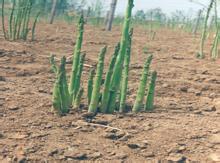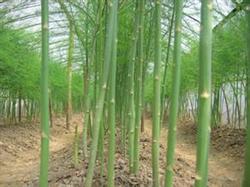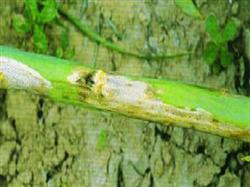Sowing and planting of asparagus in open field

Asparagus is a kind of high-grade vegetable and health food with high nutritional value, which enjoys the reputation of "king of vegetables" in the international market. The asparagus planting area in Baoding City is more than 14000 mu, of which the bamboo shoot field area is more than 8000 mu, with an annual output of more than 7500 tons. All are sold in Beijing, Tianjin and other big cities. The planting area of asparagus is expanding year by year, but most of the varieties used are f2 generation, with poor quality, low yield and relatively backward management, which can no longer meet the needs of domestic and foreign markets. Therefore, it is an important task for us to select and introduce excellent new varieties, adopt advanced management technology and improve the economic benefit of asparagus. First, soil selection. It is rich in organic matter, good in water retention and drainage, and it is suitable for loose loam or sandy loam with deep soil layer. PH is best between 5.8 and 6.7, do not raise seedlings on over-acid or heavily saline-alkali soil. Asparagus prefers light, and the stem is weak, so it is cultivated without shade, leeward or windbreak. Avoid cultivation in orchards and sweet potato fields to prevent underground pests. 2. Variety selection 1. Apollo (apollo): breeding by California asparagus seed Company. The asexual F1 hybrid has an average stem diameter of 1.59 cm, delicate texture, low fiber content, dark green color, low loose head rate and strong disease resistance. The yield of adult bamboo shoots can reach 1200-1500 kg per mu. 2. Purple passion (purplepassion): bred by California Reed seed subsidiary of the United States. The polyploid purple asparagus variety has violet tender stem, low loose head rate, juicy and slightly sweet, excellent taste of raw food and good disease resistance. The yield of adult bamboo shoots can reach 750-1000 kg per mu. 3. Atlasf1: this variety has outstanding heterosis, high yield, more than 26 grams of single bamboo shoot weight, 60 cm branching point, stout stem, tight bamboo shoot tip Baotou, dark green color and average diameter of 1.8cm. Both green and white varieties. Third, sowing technology 1, soil preparation for border: generally apply rotten barnyard manure 3000-5000 kg per mu, urea 10 kg, potassium chloride and calcium superphosphate 7-8 kg each, fully mixed into 10 cm of soil. Ploughing and raking for many times, mix evenly. Build a ridge every 110 cm, 15 cm high and 20 cm wide. The length of the border is not more than 30 meters, the surface of the border is ultra-flat, and the soil moisture is poured into the bottom for use. 2. Seed soaking and sprouting: put the seeds into a container, add 30 ℃ water equivalent to twice the seed volume to soak the seeds, and wash and change water three times a day. Soak the seeds for 48 hours and drain. The sterilization of seeds can be treated with 50% carbendazim solution for 12 hours (the pathogen to control stem blight) or 5.25% sodium hypochlorite for 10-15 minutes (killing epidermis fungi). Rinse and dry before sowing. 3. Sowing time: generally sowing and raising seedlings in the open field from the middle of July to the beginning of August, and planting dormant roots in early November, with low cost and high benefit. 4. Sowing: take the plant row spacing of 10 × 10 cm to sow on demand, generally covering soil about 4 cm. Irrigate once. According to the net sown area, generally 1100 seeds can be sowed every 11 square meters and 1 mu of land can be planted. 4, planting management 1, land preparation: first of all, leveling the land, deep ploughing about 35 cm, rake fine cuddle flat. Then dig the planting ditch (35-40 cm deep and 35-45 cm wide) according to the row spacing (150 cm), apply the soil and stable fertilizer evenly to the bottom of the ditch, 10-15 cm thick, and then carry on the chemical treatment. 50% phoxim 1000 times liquid can be evenly sprayed at the bottom of the ditch, applied chemical fertilizer, 10 kg of diammonium phosphate per mu, 8 kg of urea, 5 kg of potash fertilizer, and finally fill back about 15 cm. Pour water thoroughly, wait for the soil to sink, and then backfill the soil, so that the surface of the ditch is 10 cm away from the ground, ready for use. 2. The planting time: the planting can be carried out in the first and middle of March in spring, in the middle of July in summer and in the middle of November in autumn, which is beneficial to high yield. 3. Planting: 3 days before planting, sufficient water was irrigated in the planting ditch, and 3 days later, it was planted according to the plant distance (30-35 cm). A 10 cm deep hole was dug in the ditch, and the seedlings were placed into the hole in a straight line according to the development direction of the growing point, and the seedlings were discharged on one side and covered with soil on the other. Water after covering the soil, wait for the seedling to survive, pull out the new stem, and then cover the soil by stages until leveled with the border.
- Prev

Management techniques of fertilization and soil cultivation of asparagus
1. Fertilizing and cultivating asparagus should use more organic fertilizer to make the soil loose and fertile, which is beneficial to the development of underground stem and root system. The amount of fertilizer was comprehensively considered according to the plant growth, soil fertility and utilization rate. The growth of the plant includes the yield of tender stem, the weight of aboveground stem and underground stem and fleshy root.
- Next

Technical points of harvesting asparagus with mother stem
Asparagus stem blight is a destructive disease, known as "asparagus cancer". Once you get stem blight, the yield will be reduced, and if it is heavy, the garden will be destroyed and the harvest will be destroyed, resulting in huge losses to the majority of bamboo shoot farmers. Affected by SARS in 2003, the price of asparagus is low, many bamboo shoot farmers give up management, the occurrence of stem blight is more serious, at the same time asparagus field.
Related
- Where is it suitable to grow horseradish in China? it is expected to see the middle altitude horseradish in Alishan.
- How to prevent tomato virus disease reasonably? (Control methods included)
- Many people like to plant towel gourd on the balcony. What are the main points of this method and management?
- What crops can chili peppers be mixed with?
- Fertilization techniques and matters needing attention in Tomato
- What are the grafting techniques for peach seedlings in spring?
- Harm and control methods of root swelling disease of Chinese cabbage
- What are the pests of sweet potatoes? How to prevent and cure it?
- Symptoms, causes and Control methods of navel Rot in Tomato
- The cause of "Cucumber rotten bibcock" in Farmers' planting Cucumber and its Control Plan

